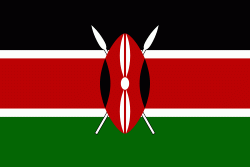Thika District (Thika District)
Thika District is a former administrative district in the Central Province of Kenya. Its capital town was Thika. The district was adjacent to the northeastern border of Nairobi. The district had a population of 645.713.
In 2010, the district was eliminated and absorbed into Kiambu County.
The district was predominantly rural, but its urban population was soaring as Nairobi is growing rapidly. Kikuyu were the dominant tribe in the district.
The district had four constituencies:
* Gatanga Constituency (consisted of Gatanga and Kakuzi divisions)
* Gatundu South Constituency
* Gatundu North Constituency
* Juja Constituency (consisted Ruiru, Juja & Thika Town)
* Research findings – Thika District
* Gatanga Constituency
In 2010, the district was eliminated and absorbed into Kiambu County.
The district was predominantly rural, but its urban population was soaring as Nairobi is growing rapidly. Kikuyu were the dominant tribe in the district.
The district had four constituencies:
* Gatanga Constituency (consisted of Gatanga and Kakuzi divisions)
* Gatundu South Constituency
* Gatundu North Constituency
* Juja Constituency (consisted Ruiru, Juja & Thika Town)
* Research findings – Thika District
* Gatanga Constituency
Map - Thika District (Thika District)
Map
Country - Kenya
 |
 |
| Flag of Kenya | |
Kenya's earliest inhabitants were hunter-gatherers, like the present-day Hadza people. According to archaeological dating of associated artifacts and skeletal material, Cushitic speakers first settled in Kenya's lowlands between 3,200 and 1,300 BC, a phase known as the Lowland Savanna Pastoral Neolithic. Nilotic-speaking pastoralists (ancestral to Kenya's Nilotic speakers) began migrating from present-day South Sudan into Kenya around 500 BC. Bantu people settled at the coast and the interior between 250 BC and 500 AD. European contact began in 1500 AD with the Portuguese Empire, and effective colonisation of Kenya began in the 19th century during the European exploration of the interior. Modern-day Kenya emerged from a protectorate established by the British Empire in 1895 and the subsequent Kenya Colony, which began in 1920. Numerous disputes between the UK and the colony led to the Mau Mau revolution, which began in 1952, and the declaration of independence in 1963. After independence, Kenya remained a member of the Commonwealth of Nations. The current constitution was adopted in 2010 and replaced the 1963 independence constitution.
Currency / Language
| ISO | Currency | Symbol | Significant figures |
|---|---|---|---|
| KES | Kenyan shilling | Sh | 2 |
| ISO | Language |
|---|---|
| EN | English language |
| SW | Swahili language |















